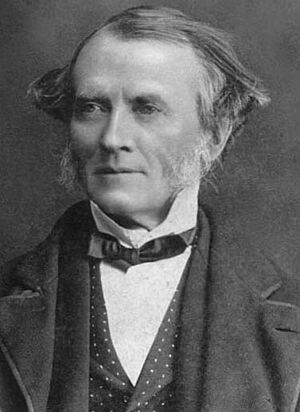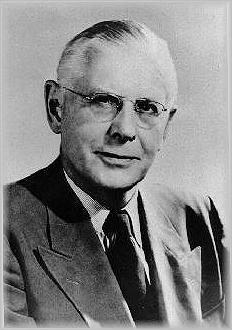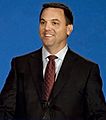Progressive Conservative Party of Ontario facts for kids
Quick facts for kids
Progressive Conservative Party of Ontario
Parti progressiste-conservateur de l'Ontario
|
|
|---|---|
 |
|
| Abbreviation | PC |
| Leader | Doug Ford |
| President | Michael Diamond |
| House leader | Steve Clark |
| Founded | 1854 (as Conservative Party of Canada West) |
| Preceded by | Upper Canada Tories |
| Headquarters | 400-56 Aberfoyle Crescent, Toronto, Ontario, Canada |
| Youth wing | Ontario Young Progressive Conservative Association |
| Membership (2018) | 133,000 |
| Ideology | Conservatism (Canadian) |
| Political position | Centre-right |
| Colours | Blue |
| Seats in the Legislature |
80 / 124
|
The Progressive Conservative Party of Ontario (PC), also known as the Ontario PC Party or simply the PCs, is a major political party in Ontario, Canada. It is considered a centre-right party. This means it often supports lower taxes, less government spending, and policies that help businesses grow.
The party is one of the oldest in Ontario and governed the province for 42 years in a row, from 1943 to 1985. During this time, the PCs were known for building roads, schools, and hospitals. They also passed laws to protect people from unfair treatment.
In the 1990s, under leader Mike Harris, the party's ideas shifted. They focused on cutting taxes and government spending in what was called the "Common Sense Revolution". After losing power in 2003, the PCs returned with a big win in 2018 under their current leader, Doug Ford. They won again in 2022 and 2025.
Contents
History of the Party
How the Party Began
The party's roots go back to before Canada was a country. In the colony of Upper Canada, the first Conservative Party was made up of wealthy and powerful families. After the Rebellions of 1837, a more modern party formed.
In 1854, Sir John A. Macdonald (who would become Canada's first prime minister) helped create the Liberal-Conservative party. A version of this party formed the very first government of Ontario in 1867, led by Premier John Sandfield Macdonald.
For many years, the party was officially called the "Liberal-Conservative Association of Ontario." In 1942, it changed its name to the Progressive Conservative Party, which is the name it still uses today.
A Long Time in Power
After 33 years as the opposition, the PCs, then called the Tories, returned to power in 1905 under James P. Whitney. His government started huge projects like the creation of Ontario Hydro. The party governed for most of the next 30 years but lost in 1934 because it struggled to handle the Great Depression.
In 1943, the Progressive Conservatives won the election and began a period of rule that would last for 42 years. This long time in power is often called a "dynasty."
During this era, leaders like George A. Drew, Leslie Frost, and John Robarts led the party. They focused on building up the province.
- They built the 400-series highways, including the Highway 401.
- They passed laws against discrimination and gave First Nations people the right to vote.
- They improved healthcare and education across Ontario.
- They supported French language rights in schools.
This version of the PC party was often called "Red Tory." This meant they were conservative but also believed the government should play a role in the economy and provide social programs.
The Big Blue Machine
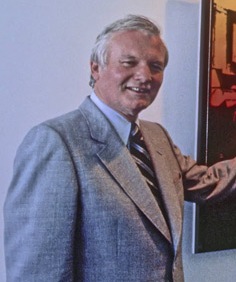
In 1971, Bill Davis became the party leader and premier. His team of smart advisors was so good at politics and strategy that they were nicknamed the "Big Blue Machine."
Under Davis, the party continued to be popular. They expanded colleges and universities and kept building highways. The PC government under Davis was seen as being in the political centre, not too far right or left.
Davis retired in 1985. His replacement, Frank Miller, was more conservative. In the 1985 election, the PCs lost their majority. Soon after, the Liberal Party and the NDP joined forces to defeat the PCs, ending their 42-year run in government.
The Common Sense Revolution
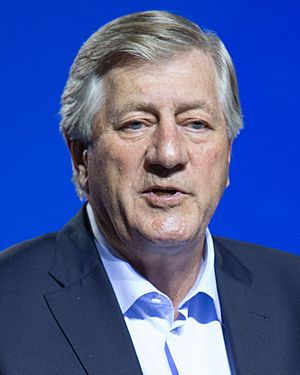
The PCs spent the next ten years in opposition. In 1990, they chose Mike Harris as their new leader.
In the 1995 election, Harris led the party to a huge victory. He ran on a platform called the "Common Sense Revolution." This plan promised big changes for Ontario, including:
- Cutting provincial income tax by 30%.
- Reducing government spending to get rid of the deficit.
- Making changes to welfare programs.
The Harris government was very controversial. There were many protests and strikes, including a major teachers' strike in 1997. But the government remained popular enough to win another majority in the 1999 election.
Years in Opposition (2003-2018)
Mike Harris stepped down in 2002 and was replaced by Ernie Eves. Eves was a more moderate leader and tried to move the party back toward the centre. However, he lost the 2003 election to the Liberals, led by Dalton McGuinty.
The PCs spent the next 15 years as the Official Opposition. The party was led by John Tory from 2004 to 2009 and then by Tim Hudak from 2009 to 2014. Both leaders were unable to defeat the Liberals in elections.
In 2015, Patrick Brown became the leader. He also tried to move the party to the political centre. He suddenly resigned as leader in January 2018, just a few months before the next election.
Return to Government under Doug Ford
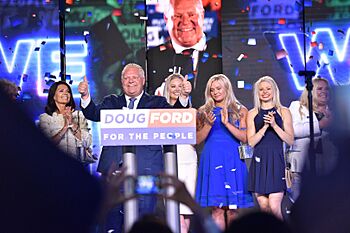
After Brown's resignation, the party quickly held a leadership election. In March 2018, Doug Ford was elected the new leader. Ford is the brother of the former mayor of Toronto, Rob Ford.
In the June 2018 election, Doug Ford led the PCs to a large majority government. The party won 76 of the 124 seats in the legislature.
The Ford government focused on the economy, promising to lower taxes and reduce regulations on businesses. In the 2022 Ontario general election, the PCs won an even larger majority, securing 83 seats. They won another majority in the 2025 Ontario general election.
What the Party Believes In
The Ontario PC Party is a conservative party that is centre-right. This means they generally support ideas that encourage individual responsibility and a strong economy. Here are some of their common goals:
- Lower Taxes: The party often campaigns on cutting taxes for people and businesses. They believe this leaves more money in people's pockets and helps the economy grow.
- Less Government Spending: They aim to balance the provincial budget and avoid debt. This can mean reducing the size and cost of government programs.
- Support for Business: The PCs often reduce rules and regulations on businesses to make it easier for them to operate and create jobs.
- Healthcare: The party supports Ontario's universal public healthcare system but has also looked at allowing private clinics to perform some publicly funded procedures to reduce wait times.
- Infrastructure: They support building more highways, roads, and public transit to help people get around.
Images for kids
See also
- List of Ontario general elections
- List of premiers of Ontario
- List of political parties in Canada
- List of political parties in Ontario


